Hyundai Sonata Hybrid 2015 User Guide
Manufacturer: HYUNDAI, Model Year: 2015, Model line: Sonata Hybrid, Model: Hyundai Sonata Hybrid 2015Pages: 543, PDF Size: 25.53 MB
Page 11 of 543
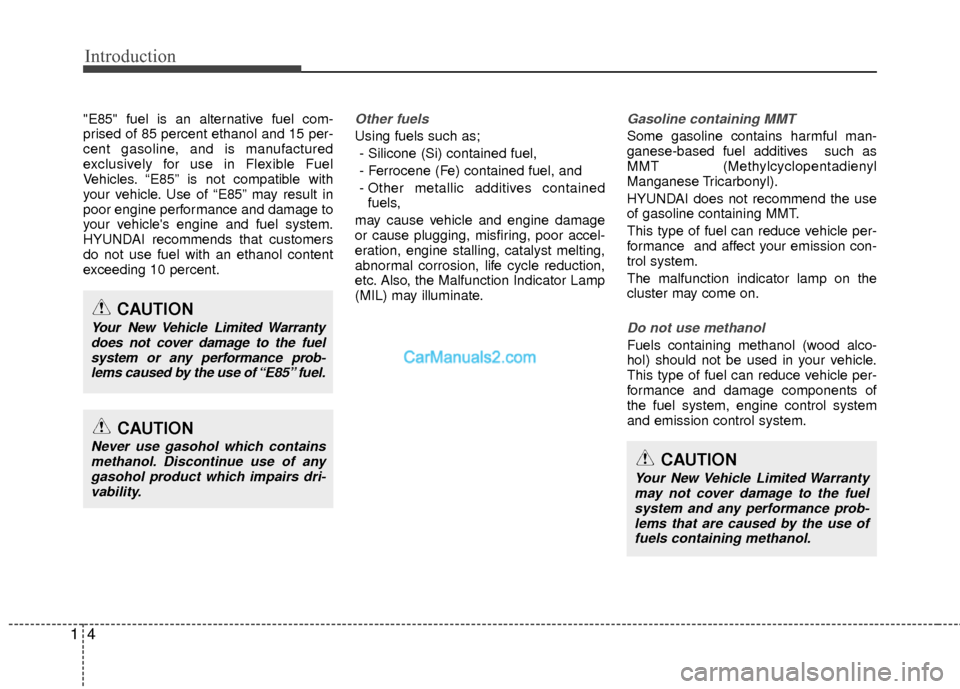
Introduction
41
"E85" fuel is an alternative fuel com-
prised of 85 percent ethanol and 15 per-
cent gasoline, and is manufactured
exclusively for use in Flexible Fuel
Vehicles. “E85” is not compatible with
your vehicle. Use of “E85” may result in
poor engine performance and damage to
your vehicle's engine and fuel system.
HYUNDAI recommends that customers
do not use fuel with an ethanol content
exceeding 10 percent.Other fuels
Using fuels such as;- Silicone (Si) contained fuel,
- Ferrocene (Fe) contained fuel, and
- Other metallic additives contained fuels,
may cause vehicle and engine damage
or cause plugging, misfiring, poor accel-
eration, engine stalling, catalyst melting,
abnormal corrosion, life cycle reduction,
etc. Also, the Malfunction Indicator Lamp
(MIL) may illuminate.
Gasoline containing MMT
Some gasoline contains harmful man-
ganese-based fuel additives such as
MMT (Methylcyclopentadienyl
Manganese Tricarbonyl).
HYUNDAI does not recommend the use
of gasoline containing MMT.
This type of fuel can reduce vehicle per-
formance and affect your emission con-
trol system.
The malfunction indicator lamp on the
cluster may come on.
Do not use methanol
Fuels containing methanol (wood alco-
hol) should not be used in your vehicle.
This type of fuel can reduce vehicle per-
formance and damage components of
the fuel system, engine control system
and emission control system.
CAUTION
Your New Vehicle Limited Warranty may not cover damage to the fuelsystem and any performance prob- lems that are caused by the use offuels containing methanol.
CAUTION
Never use gasohol which contains methanol. Discontinue use of anygasohol product which impairs dri-vability.
CAUTION
Your New Vehicle Limited Warrantydoes not cover damage to the fuelsystem or any performance prob-lems caused by the use of “E85” fuel.
Page 12 of 543
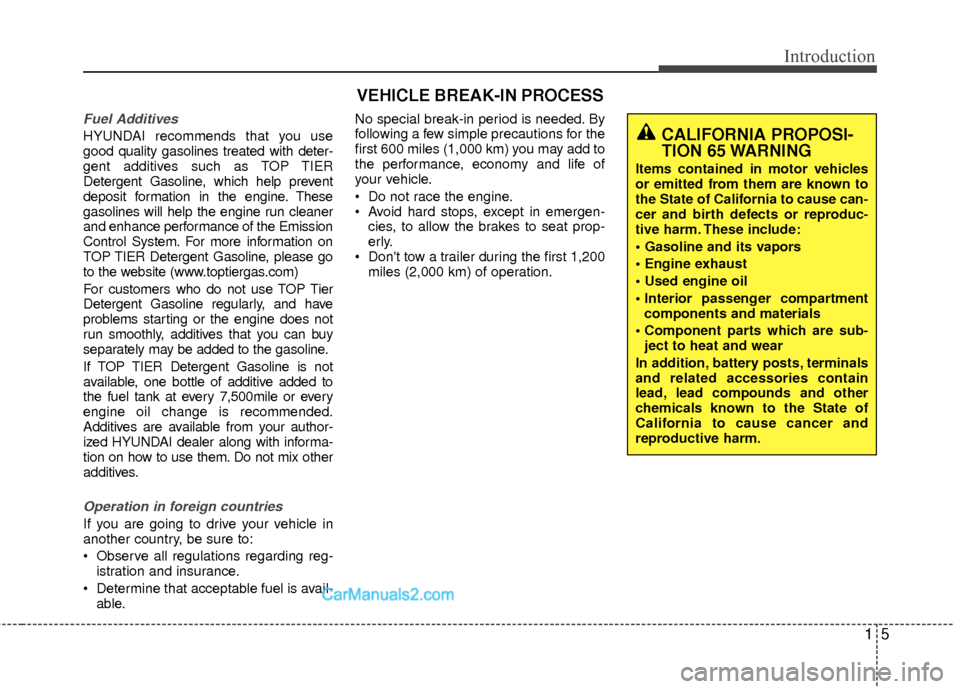
15
Introduction
Fuel Additives
HYUNDAI recommends that you use
good quality gasolines treated with deter-
gent additives such as TOP TIER
Detergent Gasoline, which help prevent
deposit formation in the engine. These
gasolines will help the engine run cleaner
and enhance performance of the Emission
Control System. For more information on
TOP TIER Detergent Gasoline, please go
to the website (www.toptiergas.com)
For customers who do not use TOP Tier
Detergent Gasoline regularly, and have
problems starting or the engine does not
run smoothly, additives that you can buy
separately may be added to the gasoline.
If TOP TIER Detergent Gasoline is not
available, one bottle of additive added to
the fuel tank at every 7,500mile or every
engine oil change is recommended.
Additives are available from your author-
ized HYUNDAI dealer along with informa-
tion on how to use them. Do not mix other
additives.
Operation in foreign countries
If you are going to drive your vehicle in
another country, be sure to:
Observe all regulations regarding reg-istration and insurance.
Determine that acceptable fuel is avail- able. No special break-in period is needed. By
following a few simple precautions for the
first 600 miles (1,000 km) you may add to
the performance, economy and life of
your vehicle.
Do not race the engine.
Avoid hard stops, except in emergen-
cies, to allow the brakes to seat prop-
erly.
Don't tow a trailer during the first 1,200 miles (2,000 km) of operation.
VEHICLE BREAK-IN PROCESS
CALIFORNIA PROPOSI-
TION 65 WARNING
Items contained in motor vehicles
or emitted from them are known to
the State of California to cause can-
cer and birth defects or reproduc-
tive harm. These include:
components and materials
ject to heat and wear
In addition, battery posts, terminals
and related accessories contain
lead, lead compounds and other
chemicals known to the State of
California to cause cancer and
reproductive harm.
Page 13 of 543
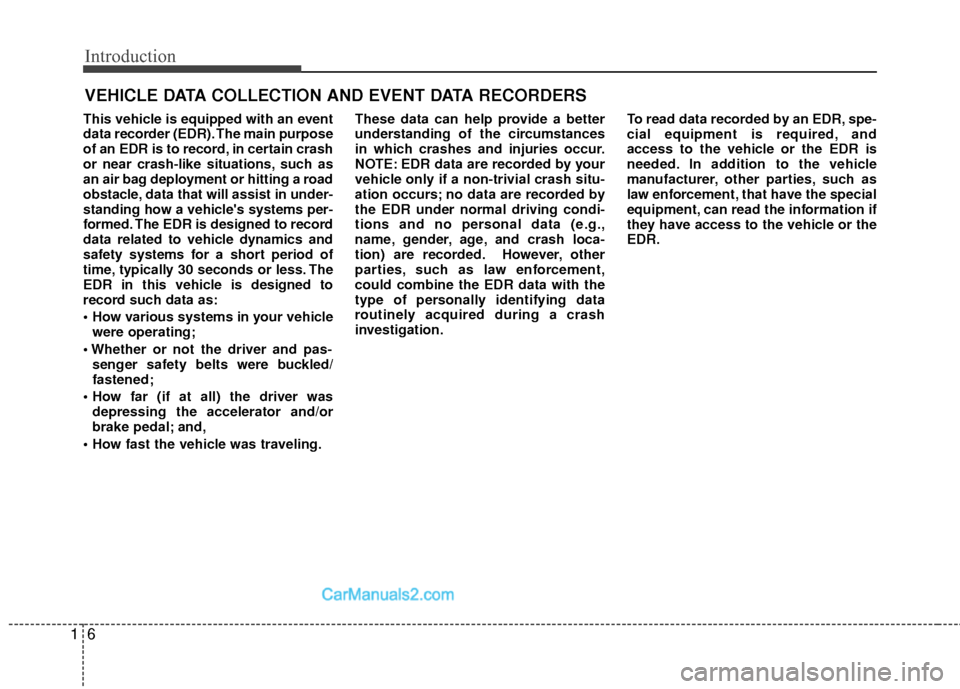
Introduction
61
This vehicle is equipped with an event
data recorder (EDR). The main purpose
of an EDR is to record, in certain crash
or near crash-like situations, such as
an air bag deployment or hitting a road
obstacle, data that will assist in under-
standing how a vehicle's systems per-
formed. The EDR is designed to record
data related to vehicle dynamics and
safety systems for a short period of
time, typically 30 seconds or less. The
EDR in this vehicle is designed to
record such data as:
were operating;
senger safety belts were buckled/
fastened;
depressing the accelerator and/or
brake pedal; and,
These data can help provide a better
understanding of the circumstances
in which crashes and injuries occur.
NOTE: EDR data are recorded by your
vehicle only if a non-trivial crash situ-
ation occurs; no data are recorded by
the EDR under normal driving condi-
tions and no personal data (e.g.,
name, gender, age, and crash loca-
tion) are recorded. However, other
parties, such as law enforcement,
could combine the EDR data with the
type of personally identifying data
routinely acquired during a crash
investigation.
To read data recorded by an EDR, spe-
cial equipment is required, and
access to the vehicle or the EDR is
needed. In addition to the vehicle
manufacturer, other parties, such as
law enforcement, that have the special
equipment, can read the information if
they have access to the vehicle or the
EDR.
VEHICLE DATA COLLECTION AND EVENT DATA RECORDERS
Page 14 of 543
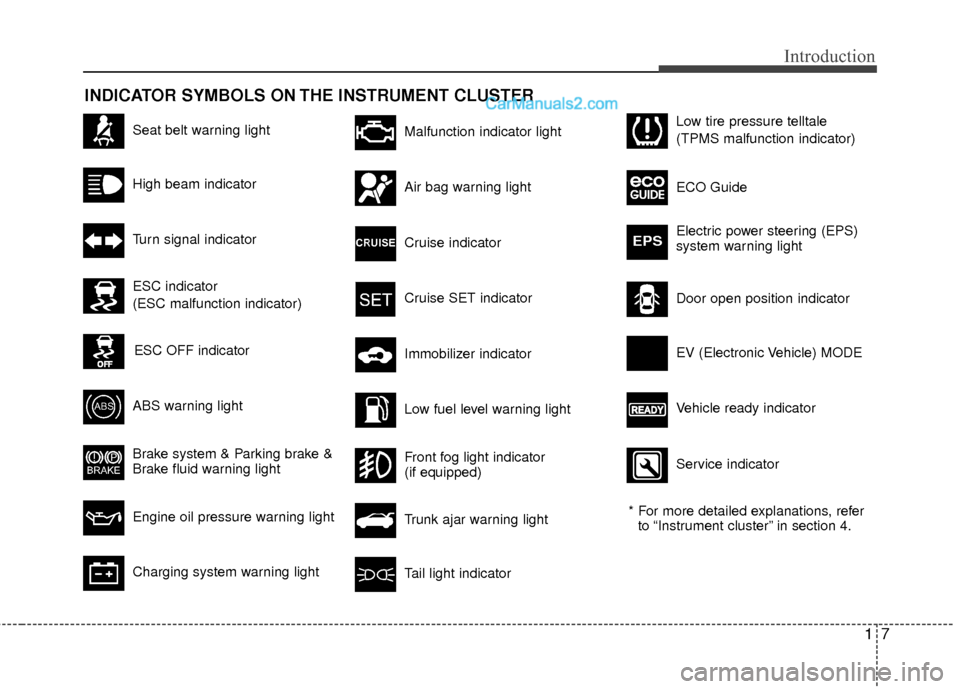
17
Introduction
INDICATOR SYMBOLS ON THE INSTRUMENT CLUSTER
Seat belt warning light
High beam indicator
Turn signal indicator
ABS warning light
Brake system & Parking brake &
Brake fluid warning light
Engine oil pressure warning light
Malfunction indicator light
Air bag warning light
Cruise indicator
Cruise SET indicator
Immobilizer indicator
Low fuel level warning light* For more detailed explanations, referto “Instrument cluster” in section 4.
Charging system warning lightTail light indicator
Trunk ajar warning light
Front fog light indicator
(if equipped)
Door open position indicator Low tire pressure telltale
(TPMS malfunction indicator)
ECO Guide
Electric power steering (EPS)
system warning light
EPS
ESC indicator
(ESC malfunction indicator)
ESC OFF indicator
Vehicle ready indicator EV (Electronic Vehicle) MODE
Service indicator
Page 15 of 543

2
Interior overview / 2-2
Instrument panel overview / 2-3
Engine compartment / 2-4
Trunk overview / 2-5
Your vehicle at a glance
Page 16 of 543
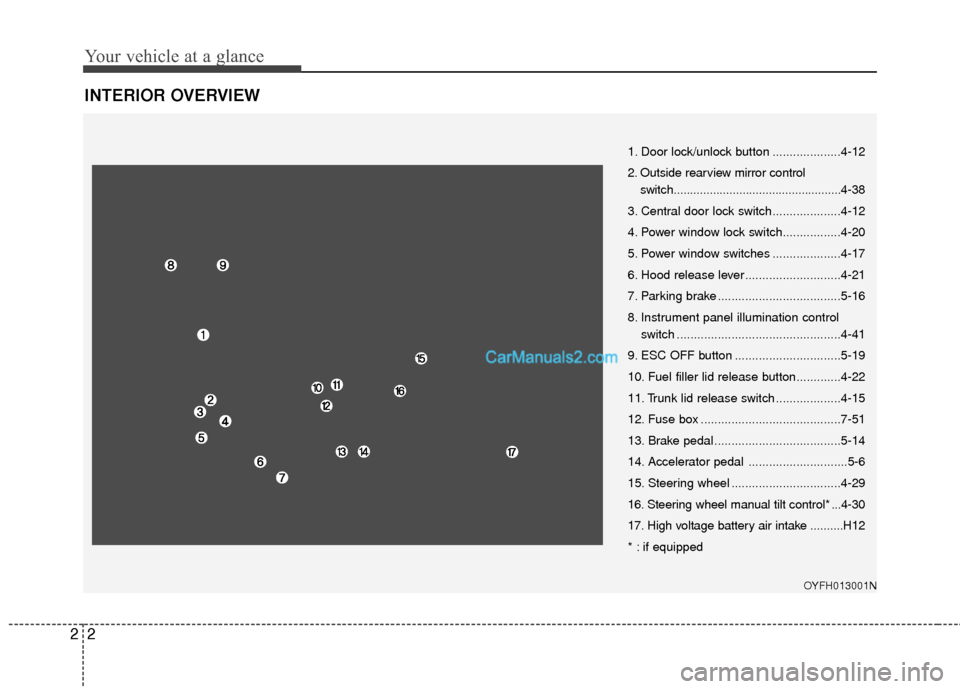
Your vehicle at a glance
22
INTERIOR OVERVIEW
OYFH013001N
1. Door lock/unlock button ....................4-12
2. Outside rearview mirror control switch...................................................4-38
3. Central door lock switch....................4-12
4. Power window lock switch.................4-20
5. Power window switches ....................4-17
6. Hood release lever ............................4-21
7. Parking brake ....................................5-16
8. Instrument panel illumination control switch ................................................4-41
9. ESC OFF button ...............................5-19
10. Fuel filler lid release button.............4-22
11. Trunk lid release switch ...................4-15
12. Fuse box .........................................7-51
13. Brake pedal .....................................5-14
14. Accelerator pedal .............................5-6
15. Steering wheel ................................4-29
16. Steering wheel manual tilt control* ...4-30
17. High voltage battery air intake ..........H12
* : if equipped
Page 17 of 543
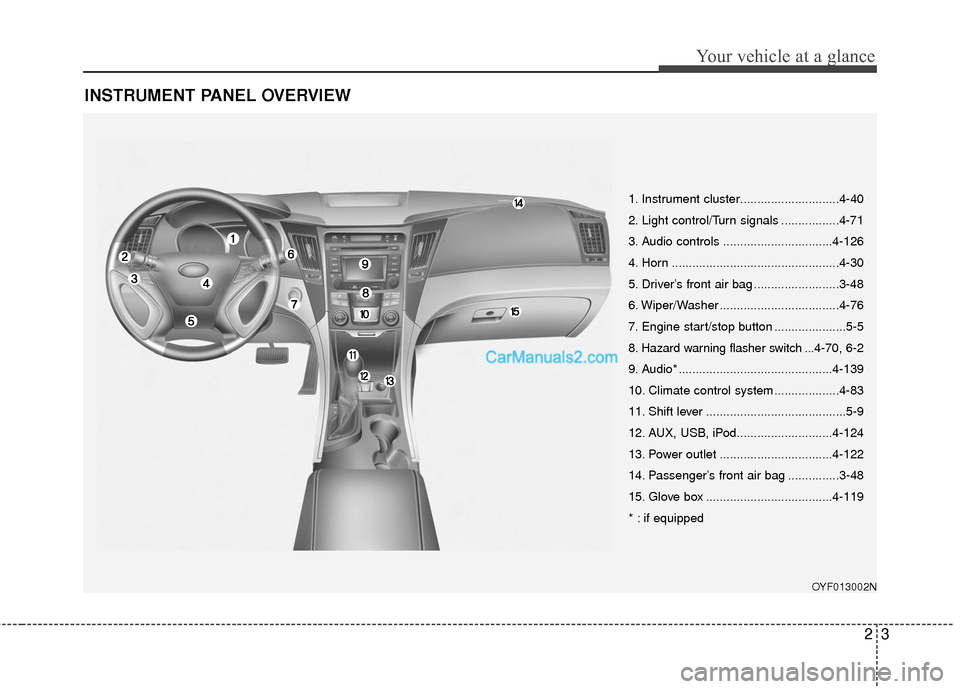
23
Your vehicle at a glance
INSTRUMENT PANEL OVERVIEW
OYF013002N
1. Instrument cluster.............................4-40
2. Light control/Turn signals .................4-71
3. Audio controls ................................4-126
4. Horn .................................................4-30
5. Driver’s front air bag .........................3-48
6. Wiper/Washer ...................................4-76
7. Engine start/stop button .....................5-5
8. Hazard warning flasher switch ...4-70, 6-2
9. Audio* .............................................4-139
10. Climate control system ...................4-83
11. Shift lever .........................................5-9
12. AUX, USB, iPod............................4-124
13. Power outlet .................................4-122
14. Passenger’s front air bag ...............3-48
15. Glove box .....................................4-119
* : if equipped
Page 18 of 543
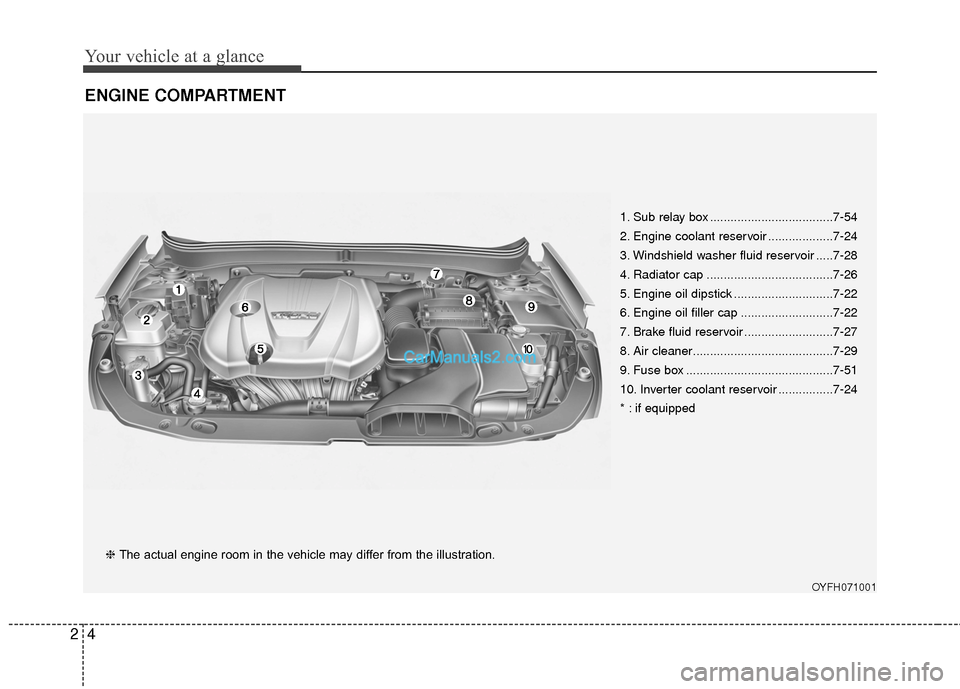
Your vehicle at a glance
42
ENGINE COMPARTMENT
OYFH071001
❈ The actual engine room in the vehicle may differ from the illustration. 1. Sub relay box ....................................7-54
2. Engine coolant reservoir ...................7-24
3. Windshield washer fluid reservoir .....7-28
4. Radiator cap .....................................7-26
5. Engine oil dipstick .............................7-22
6. Engine oil filler cap ...........................7-22
7. Brake fluid reservoir ..........................7-27
8. Air cleaner.........................................7-29
9. Fuse box ...........................................7-51
10. Inverter coolant reservoir ................7-24
* : if equipped
Page 19 of 543
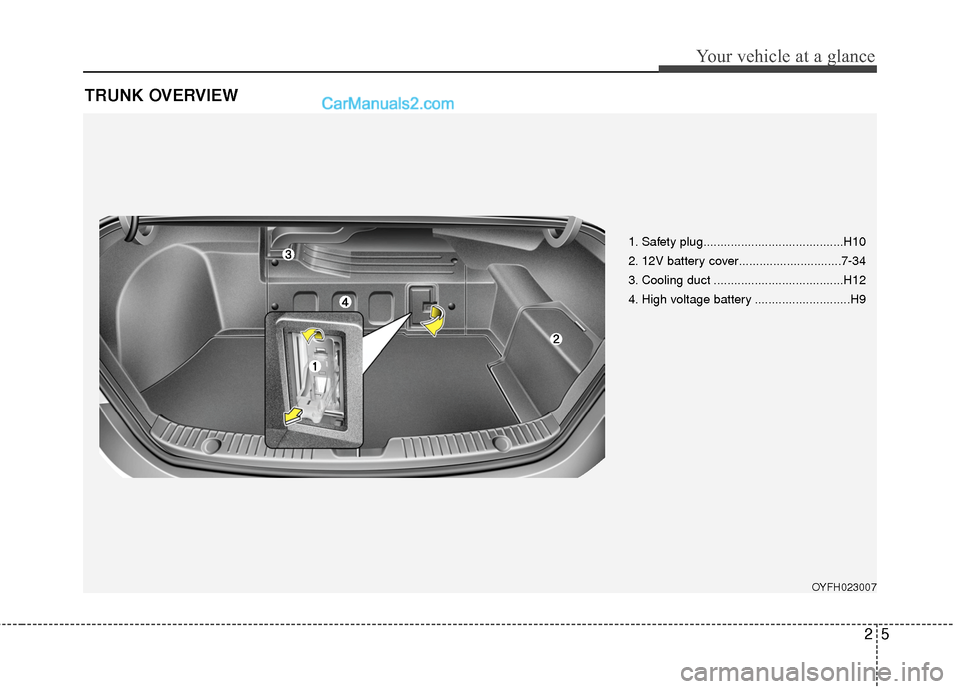
25
Your vehicle at a glance
TRUNK OVERVIEW
OYFH023007
1. Safety plug.........................................H10
2. 12V battery cover..............................7-34
3. Cooling duct ......................................H12
4. High voltage battery ............................H9
Page 20 of 543
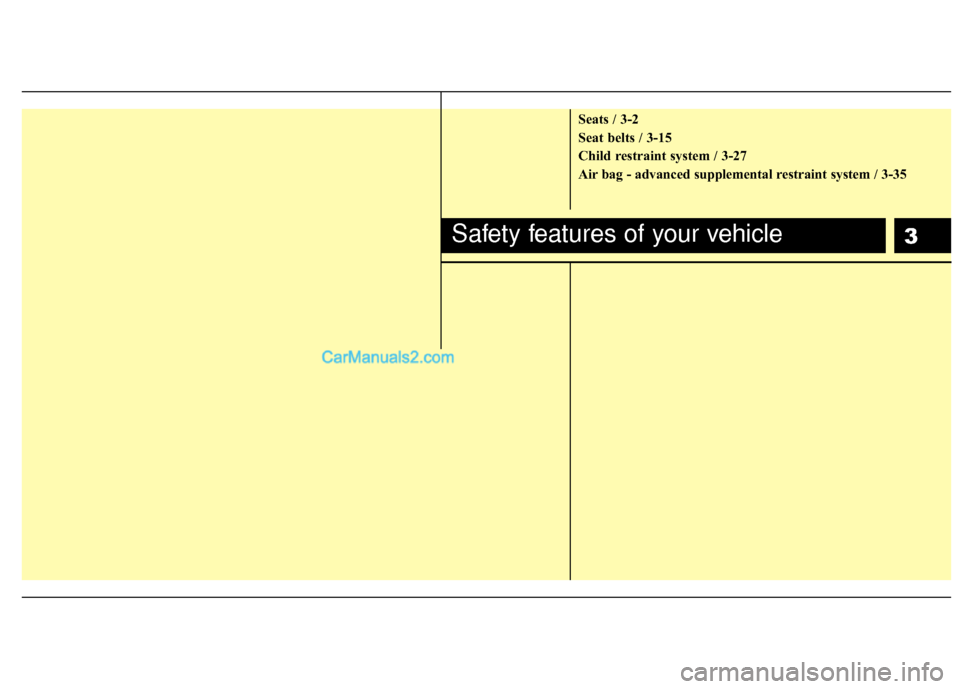
3
Seats / 3-2
Seat belts / 3-15
Child restraint system / 3-27
Air bag - advanced supplemental restraint system / 3-35
Safety features of your vehicle